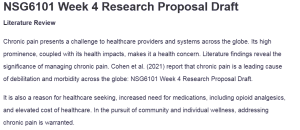NSG6101 Week 4 Research Proposal Draft
Literature Review
Chronic pain presents a challenge to healthcare providers and systems across the globe. Its high prominence, coupled with its health impacts, makes it a health concern. Literature findings reveal the significance of managing chronic pain. Cohen et al. (2021) report that chronic pain is a leading cause of debilitation and morbidity across the globe: NSG6101 Week 4 Research Proposal Draft.
It is also a reason for healthcare seeking, increased need for medications, including opioid analgesics, and elevated cost of healthcare. In the pursuit of community and individual wellness, addressing chronic pain is warranted.
Comprehensive management of chronic pain has traditionally integrated pharmacotherapeutic and non-pharmacotherapeutic interventions. These modalities maintain effectiveness in alleviating pain and improving individual wellness and quality of life. There is a literature consensus on the adjunctive use of pharmacotherapy and non-pharmacotherapy in managing chronic pain.
Saleh (2023) notes that medications and alternative modalities, such as acupuncture and exercise, when used in combination, produce superior effects than either agent used alone. It is thus imperative that healthcare providers understand diverse therapeutic modalities effective against chronic pain.
Despite the abundance of multiple management modalities against chronic pain, inadequate treatment persists. Fekede et al. (2023) note that the management of chronic pain remains inadequate across healthcare settings. It becomes apparent when the pain is not properly assessed, wrong doses are administered to the patients, patients’ reluctance to seek therapy, and the etiological factors underlying the pain are not properly assessed. These factors often result in undertreatment with consequent persistence of pain, deterioration in the quality of life of the affected individuals, and a growing need for stronger analgesics, such as opioids.
Tata et al. (2024) note that insufficient management of chronic pain has a multi-factorial etiology. These factors can be categorized into patient-related, healthcare settings-related, and caregiver-related factors. Patient factors, such as refusal or reluctance to disclose the pain, remain a barrier to adequate management of chronic pain.
Likewise, provider factors such as misconception of diverse pain types, poor characterization and evaluation of chronic pain, and biases during pain evaluation may result in poor or inadequate management of chronic pain. Systems factors, such as care fragmentation, can also be blamed for insufficient management of chronic pain.
Inadequate management of pain has far-reaching effects on the patients, the healthcare providers, and the system in its entirety. Alzghoul et al. (2022) note that insufficient management of chronic pain is a reason for significant deterioration in the quality of life of the affected individuals. It has also been associated with the increased need for opioid analgesics and hospitalizations.
Ellis et al. (2021) document the association between poorly managed chronic pain and the opioid crisis in the US and other countries. Poor management of chronic pain results in over-reliance on opioid medications and subsequent addiction. This perpetuates the opioid crisis and elevates the cost of managing chronic pain.
Mangolianshahrbabaki et al. (2024) detail the impact of inadequate pain management on healthcare organizations and systems. Poorly managed chronic pain increases the rates of preventable hospitalization and consumption of healthcare resources. This may result in strains in the systems demonstrated by high work burden to the caregivers.
Likewise, complications related to chronic pain may be challenging for some caregivers. Failures to accurately diagnose and manage chronic pain may also contribute to opioid use disorders secondary to over-reliance. This may increase morbidity rates, further stretching the available healthcare resources.
References
Alzghoul, B. I., Al Humoud, S., & Abdullah, N. A. (2022). Patient-related barriers to effective pain management: A cross-sectional survey of Jordanian nurses. The Open Public Health Journal, 15(1). https://doi.org/10.2174/18749445-v15-e2207270
Cohen, S. P., Vase, L., & Hooten, W. M. (2021). Chronic pain: An update on burden, best practices, and new advances. The Lancet, 397(10289), 2082–2097. https://doi.org/10.1016/s0140-6736(21)00393-7
Ellis, M. S., Kasper, Z., & Cicero, T. (2021). Assessment of chronic pain management in the treatment of opioid use disorder: Gaps in care and implications for treatment outcomes. The Journal of Pain, 22(4), 432–439. https://doi.org/10.1016/j.jpain.2020.10.005
Fekede, L., Temesgen, W. A., Gedamu, H., Kindie, S., Bekele, T. G., Abebaw, A., Baymot, A., & Difer, M. (2023). Nurses’ pain management practices for admitted patients at the comprehensive specialized hospitals and its associated factors, a multi-center study. BMC Nursing, 22(1). https://doi.org/10.1186/s12912-023-01528-x
Mangolianshahrbabaki, P., Farokhzadian, J., Ahmadi, F., & Khabazadeh, F. (2024). Nurses’ perceptions of pain management facilitators for cancer patients: A qualitative study. Pain Management Nursing. https://doi.org/10.1016/j.pmn.2024.09.008
Saleh, A. M. (2023). Nurses’ assessment and management practices of pain among intensive care patients in King Khalid Hospital, Kharj, Riyadh. Heliyon, 9(9). https://doi.org/10.1016/j.heliyon.2023.e19986
Tata, T. K., Ohene, L. A., Dzansi, G. A., & Aziato, L. (2024). Factors influencing nurses’ pain assessment and management of Road Traffic Casualties: A qualitative study at a military hospital in Ghana. BMC Emergency Medicine, 24(1). https://doi.org/10.1186/s12873-024-01016-8
ORDER A PLAGIARISM-FREE PAPER HERE
We’ll write everything from scratch
Question
Week 4 Midweek Assignment
Assignment
Due January 31at 11:59 PM
Research Proposal Draft
By the due date assigned, write a (2–3 pages) paper addressing the sections below of the research proposal.
This week you will submit the Literature Review section of your proposal. Each week you have been adding to your growing body of evidence to support your problem and proposed innovation to address the problem. The review of literature is a critical, analytical summary and synthesis of the current knowledge of your research topic. Thus it should compare and relate different theories, findings, etc., rather than just summarize them individually.

NSG6101 Week 4 Research Proposal Draft
The following resources will help guide you (in addition to our course textbooks):

